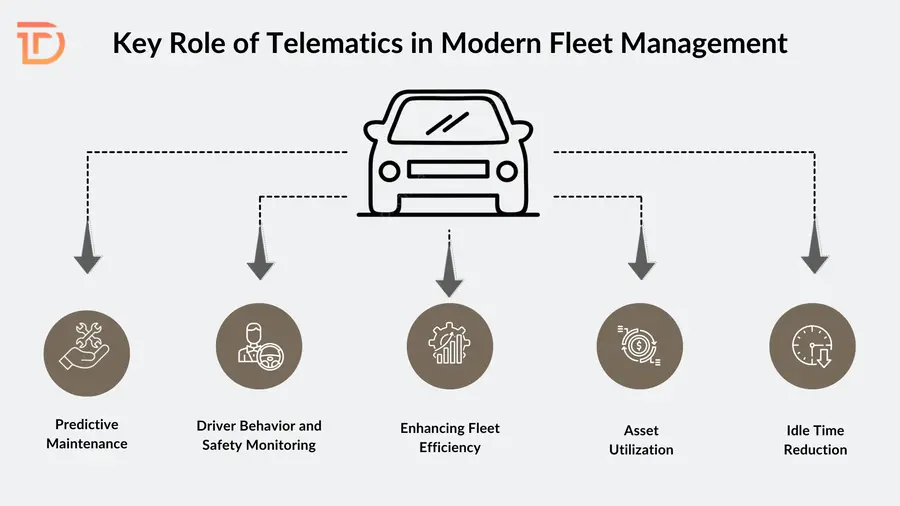The transportation industry is evolving rapidly with the advent of vehicle tracking systems and telematics. Employing both technologies in fleet management results in efficiency, improved safety, and cost savings—while also driving sustainability through reduced fuel consumption and smarter resource utilization. It acts as a powerful ally for fleet operators to enhance brand reputation while contributing to improving environmental impact.
Apart from the energy and industrial sectors, the transportation sector is also a major contributor to greenhouse gas emissions. Its heavy reliance on fossil fuels significantly impacts the environment, highlighting the urgent need for sustainable practices. Telematics has emerged as a powerful tool to support sustainability while also delivering expense reduction. In this blog, we’ll discuss what vehicle tracking system and telematics is, key role of telematics in modern fleet management, ways to enhance fleet efficiency through data-driven operations, how telematics can be used to monitor driver behavior and prevent accidents, cost reduction through fuel management, and sustainability benefits through telematics.
Understanding Vehicle Tracking Systems and Telematics
A vehicle tracking system employs GPS technology to offer real-time tracking of vehicle location and movement. It consists of hardware devices installed in vehicles that transmit location data to centralized management platforms accessible through web interfaces and mobile applications.
On the other hand, telematics is a fusion of telecommunication and informatics, enabling dynamic collection and transmission of data about vehicle location, performance, and driver behavior. This data is then moved to centralized platforms where it can be analyzed to improve fleet efficiency, reduce costs, and enhance safety.
The main difference between vehicle tracking and telematics is that while tracking only shows a unit’s location, a telematics system also provides additional performance and operational data. In other words, tracking is a component of telematics, which provides a more comprehensive view of fleet operations
Key Role of Telematics in Modern Fleet Management
Telematics plays a key role in addressing challenges faced by today’s fleets, such as fuel costs, regulatory compliance, and sustainability demands. By integrating telematics, fleet managers can monitor vehicle performance, ensure driver safety, and track behavioral patterns.

Telematics in modern fleet management serves multiple crucial functions, such as:
Predictive Maintenance
Telematics creates the data backbone for predictive maintenance programs. By continuously monitoring engine performance, tire pressure, and other key systems, telematics gives fleet managers real-time visibility into vehicle health. This allows early detection of potential issues, helping prevent costly breakdowns and minimize unplanned downtime. This proactive maintenance approach extends vehicle lifespan and ensures fleet reliability.
Driver Behavior and Safety Monitoring
Modern telematics systems track driver behavior, including speeding, harsh braking, and excessive idling. This data allows fleet managers to implement targeted training and behavior modification programs, promoting safer driving practices. Improved driver safety reduces the risk of accidents, lowers insurance costs, and contributes to fuel efficiency and reduced emissions, supporting sustainability goals.
Enhancing Fleet Efficiency
Enhancing fleet efficiency is one of the primary value propositions of vehicle tracking and telematics systems. It identifies underutilized vehicles, improves asset deployment, and ensures optimal scheduling. Automated dispatch systems assign jobs based on driver location and availability, reducing response times and unnecessary travel. By enhancing resource allocation, telematics ensures maximum productivity from the fleet while minimizing costs and environmental impact.
Asset utilization
It identifies underutilized vehicles that generate fixed costs without proportional value contribution. Telematics data reveals actual usage patterns of the fleet. It gives fleet managers an understanding of how to collect asset usage data and, based on that, better control of asset maintenance and related spending. Such insights reduce capital investment requirements, insurance costs, and maintenance expenses while supporting sustainability through reduced overall vehicle population.
Idle time reduction
Reducing idle time is one of the key concerns in vehicle management. Integration of telematics provides managers crucial information to monitor engine idle time and implement corrective actions like driver training and route optimization. Targeted idle reduction programs typically decrease idle time by 20-40%, offering benefits such as fuel savings, lower greenhouse emissions, and increased overall fleet productivity.
How Can Telematics Be Used to Monitor Driver Behavior and Prevent Accidents?
According to the World Health Organization, approximately 1.19 million people die each year due to road traffic crashes. Though there are several factors resulting in vehicle-related accidents, reckless driving style and human errors are particularly ranked as leading contributors to such incidents across the globe. Telematics can pinpoint specific driving behaviors that increase the risk of accidents. Through telematics, driving data is collected, which includes phone use, speeding, and sudden brakes, and is further combined into a single driving score that shows if the driver is driving safely or not.
Driver scorecards generated from telematics data provide objective performance assessments that support coaching and training programs. Rather than relying on subjective observations or complaint-driven feedback, fleet managers can identify specific improvement opportunities for individual drivers. Gamification elements that recognize and reward safe driving behaviors enhance program effectiveness by making safety improvement engaging rather than traditional methods.
The benefits of driver behavior monitoring extend beyond accidental cases. Reducing harsh driving reduces vehicle wear, extends the lifespan of vehicle components, and improves fuel efficiency. Organizations implementing comprehensive driver behavior programs typically reduce accident rates by 20-35% while achieving 10-15% fuel efficiency improvements.
Cost Reduction Through Fuel Management
Fuel represents the largest variable cost in fleet operations, often accounting for 30-60% of total operating expenses. Vehicle tracking and telematics systems address fuel costs through multiple mechanisms that identify and eliminate waste. Here’s how telematics can result in fuel management:
Speed management
Efficient speed management plays a crucial role in reducing fuel costs. Vehicles consume significantly more fuel at higher speeds due to increased aerodynamic drag and engine load. By maintaining optimal speed ranges, fleet operators can improve fuel efficiency and reduce unnecessary fuel wastage. Telematics systems help monitor driving behavior, flagging instances of overspeeding and enabling managers to coach drivers toward more economical driving patterns.
Route optimization
With route optimization, you can eliminate unnecessary mileage through intelligent path selection that considers traffic conditions, delivery sequences, and fuel efficiency. Every mile eliminated represents direct fuel savings along with reduced vehicle wear and lower emissions. Organizations implementing comprehensive route optimization programs typically reduce total miles driven by 15-25%, generating proportional fuel savings.
Maintenance optimization
Through maintenance optimization, vehicles showcase optimal efficiency. Poorly maintained vehicles with underinflated tires, dirty air filters, or engine problems consume significantly more fuel than properly maintained vehicles. Telematics systems monitor maintenance intervals and diagnostic trouble codes, ensuring timely service that prevents efficiency degradation.
Environmental Sustainability Benefits
Industries are increasingly becoming environmentally conscious. For fleet managers, the shift towards environmentally conscious choices is not just about fulfilling environmental responsibility, but it’s also about achieving efficiency, cost reduction, and alignment with the modern sustainability goals.
Here’s how telematics can be used to avail environmental sustainability:
Low-emission transport
Traditional GPS systems used in vehicles suggest only the fastest or the shortest route to the destination. However, telematics has the capability of suggesting the cleanest route, minimizing fuel consumption and emissions.
Further telematics supports eco-driving feedback. This tells the driver when to accelerate smoothly, avoid unnecessary idling, etc., resulting in lower emissions.
Redesign urban traffic flows
As telematics devices collect real-time data on vehicle movement, insights from this data help identify congestion hotspots and optimize traffic management strategies, reducing instances of harsh braking, acceleration, and idling. Data collected can be used for smarter road planning, leading to reduced urban air pollution and better quality of life in cities.
Electric vehicle integration
Telematics makes EV adoption smoother by supporting charging infrastructure, battery life, and optimal energy use. This accelerates the transition away from fossil fuels. Reliable EV integration helps build a low-carbon transport system, central to sustainability targets.
Conclusion
To sum up, vehicle tracking and telematics have become key tools to gather and transmit critical vehicle data, resulting in cost savings and sustainable practices. It has transformed the transportation industry and continues to do so through comprehensive monitoring, intelligent analytics, and actionable insights, resulting in benefits such as reduced fuel consumption, optimized maintenance, improved safety, and enhanced overall operational efficiency.
The sustainability benefits prove equally significant, with carbon emission reductions proportional to fuel savings, support for electric vehicle adoption, and redesigning traffic flows. As the digital transformation in the automotive industry continues to accelerate, opting for fleet management software development services would be well positioned for success.
With 10 years of experience in developing customized software solutions, Dreamer Technoland positions itself as a trusted partner for businesses seeking to leverage telematics, data analytics, and IoT-driven applications. By delivering scalable and efficient fleet management platforms, the company helps organizations enhance operational efficiency, reduce environmental impact, and stay ahead in the rapidly evolving landscape of sustainable transportation.







